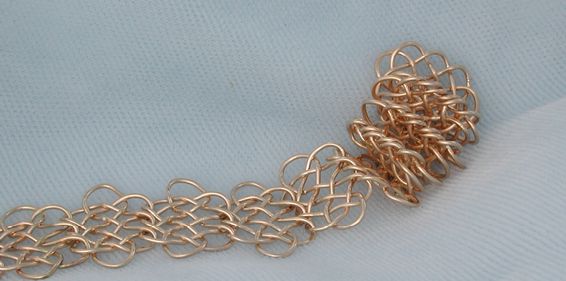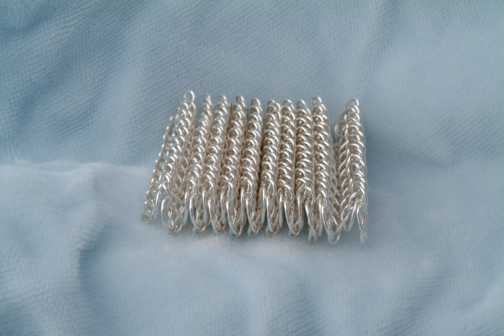|
I don't do many chains, as they are extremely labor intensive and I can't afford to sell them at prices anyone can afford. In the early eighties I made a knotted chain that consisted of seventy 3-lead by 2-bight Turk's Heads, and at the time I swore I'd never do another. A couple of years ago I needed to make a very special chain for a beautiful opal pendant, a chain that consisted of 136 individual 5-lead by 6-bight Turk's Head rings, tied sequentially and interlinked.
|

|
This is a flat-linked chain, using the "Ocean Plat" knot. (More)
|
|
The Ocean Plat and the Prolong Knot are closely related. They start with the overhand knot and the carrick bend, respectively, and both can be extended lengthwise. No matter how long they are, the middle appears to be a six-lead flat braid, and the ends have the wire looping out and back into the body of the knot in the same way. Below you see a knot that has ten loops on each side -- I'm thinking of making a chain with links like this, as a watch-band, but it might be too wide.
|
Okay, the temptation was too great to resist, so here's the chain, a bracelet consisting of twenty links. The measured length is 7 3/4", the width is 1 1/3", and it took twenty feet of wire to complete it. There's a more detailed picture here.
By the way, these knots are tied in exactly the same way as my Prolong Knot bracelets, so anyone who has taken my bracelet workshop will theoretically be able to do similar work. There are some more examples of this sort of chain on this page.
|

One of the really interesting aspects of this chain is the way it will fold up. I pack it down into this shape and show it to someone, saying "This is a bracelet," and they look at me very oddly.
|
Prices for chains are based on the complexity of the knotted links, just as I base ring prices on the complexity of the knots used. The sum of the link's crossings and the number of interlocking connections to the next link is the base, which is multiplied by a factor determined by the material used. Silver is soft and easy to work with, and costs the least; gold is harder but very durable, and platinum, while softer than gold when annealed, is considerably more difficult to deal with.
If you are interested in getting a chain made for you, bear in mind that they generally grow by only a few links per week. A bracelet might take me an entire month, and a necklace could take from six months to a year to complete. I've worked up a schedule of per-link costs for silver, gold, and platinum Prolong Knot chains.
|
|
|